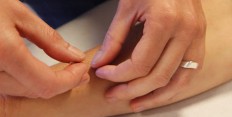About the Japanese Style of Acupuncture
Japanese acupuncture differs significantly from other acupuncture styles on account of the inherent delicacy of its techniques. These have largely developed because, for the last three-hundred-and-fifty years, the leading figures in its development have been blind. In fact even today as many as 40% of acupuncturists in Japan are visually impaired.
The most obvious difference between Japanese and (say) Chinese practice today is that the needles used are much finer - often barely thicker than a human hair. They are also inserted more superficially, often only just 1 or 2 mm, and sometimes even not inserted at all but merely subtly manipulated on the skin.

Such techniques, however, demand far greater precision in technique than with normal acupuncture. Whilst this presents a challenge for the practitioner, it is a welcome bonus for the patient - because its methods are, to all intents and purposes, painless.
Even moxibustion is done differently. In the tradition of the minimalism and elegance which is generally characteristic of Japanese culture, when moxa is burnt on the points themselves, it is of the highest refinement, and rarely uses pieces larger than the size of sesame seeds.
As with all of acupuncture, there are differing styles within Japanese practice. The methods which inform my practice more than any other are ones that were developed by three of the greats of twentieth century acupuncture, Dr Yoshio Manaka, Kobe Akabane and Kodo Fukushima.
Toyohari (a particular style of Japanese acupuncture) is one of the finest, if not the finest example of the delicacy of Japanese acupuncture today.